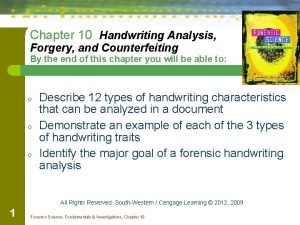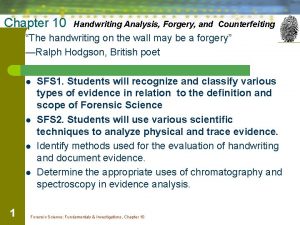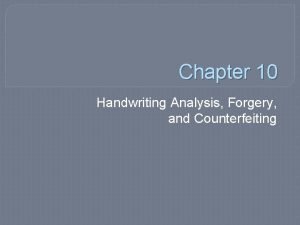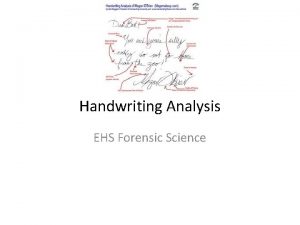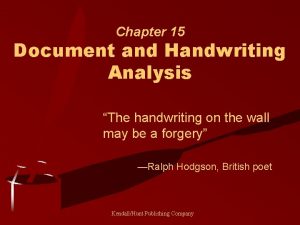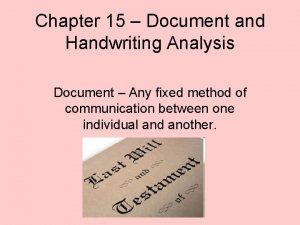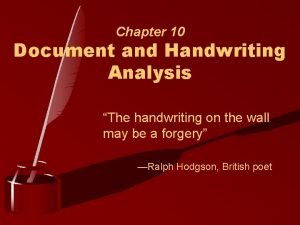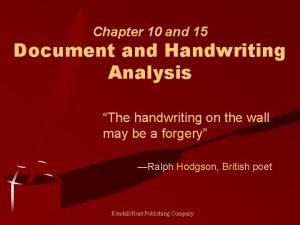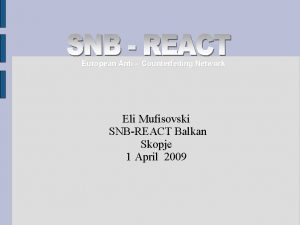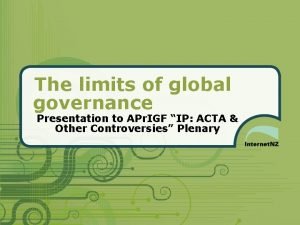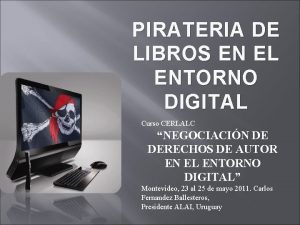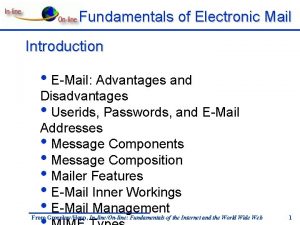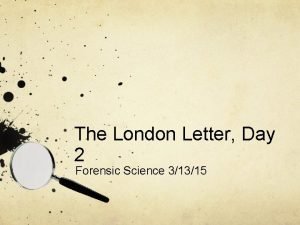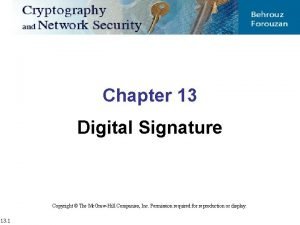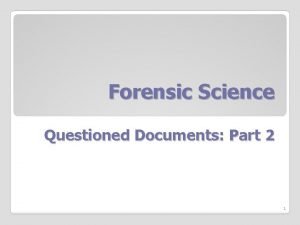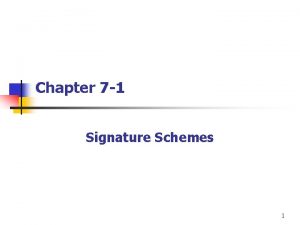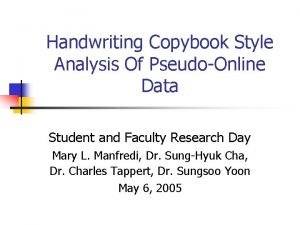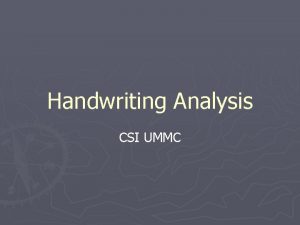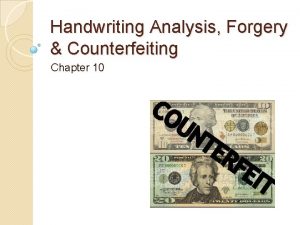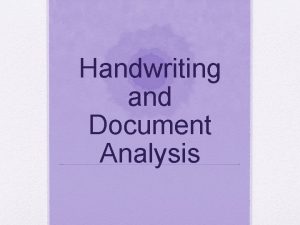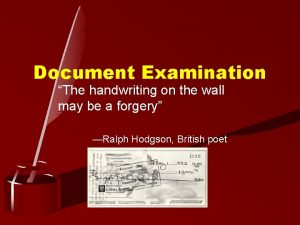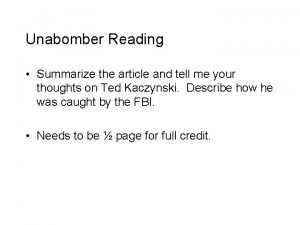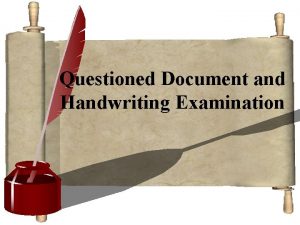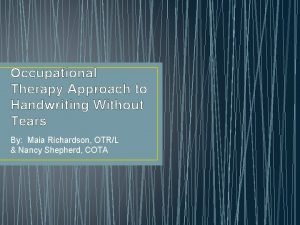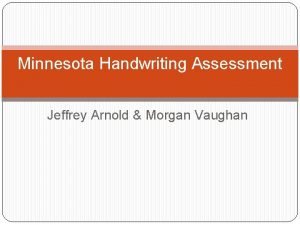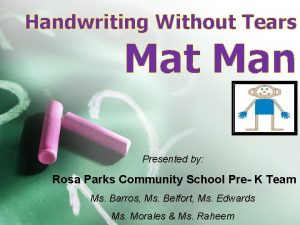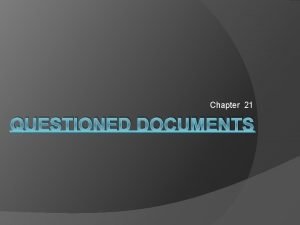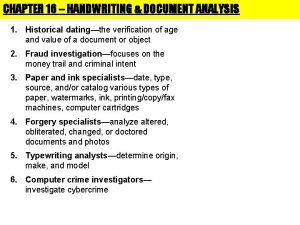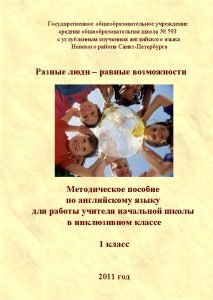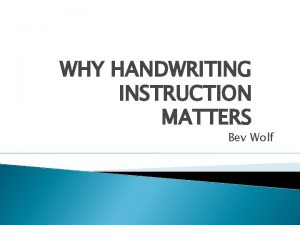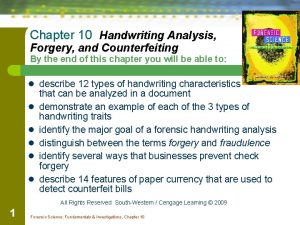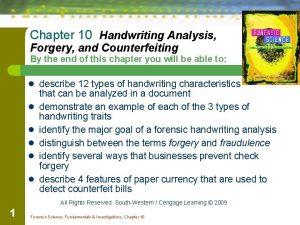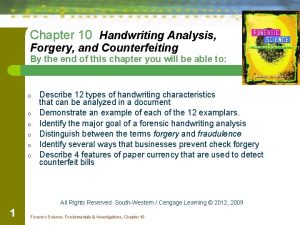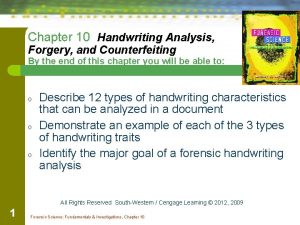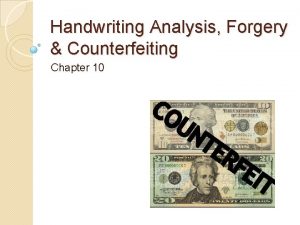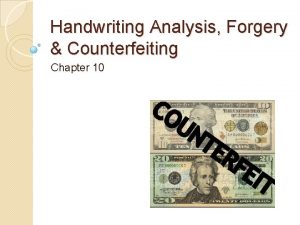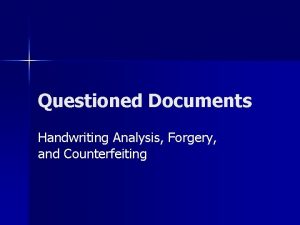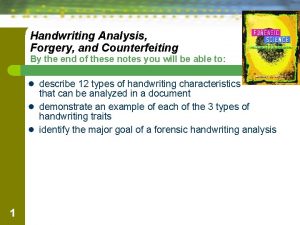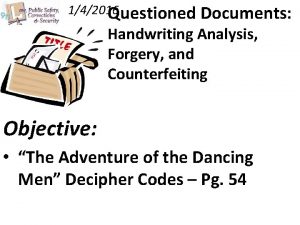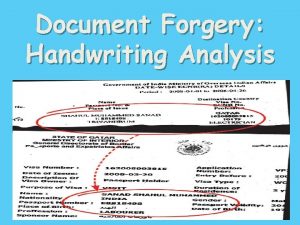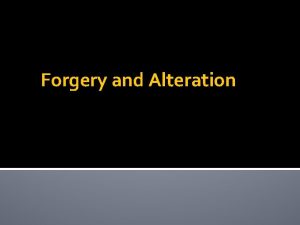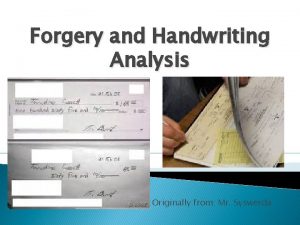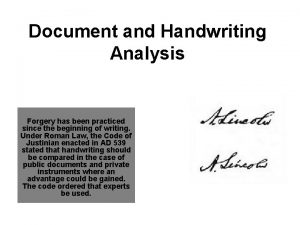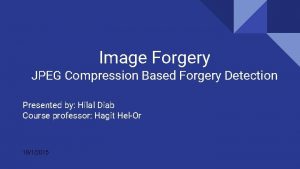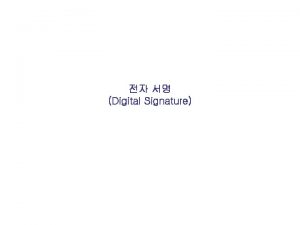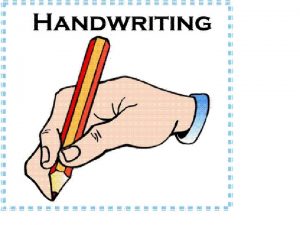Chapter 10 Handwriting Analysis Forgery and Counterfeiting The




































- Slides: 36

Chapter 10 Handwriting Analysis, Forgery, and Counterfeiting “The handwriting on the wall may be a forgery” —Ralph Hodgson, British poet Change Your Life

VOCABULARY Counterfeiting ●Document analysis ●Document expert ●Exemplar ●Forgery ●Fraudulence ●Questioned document ● Chapter 10 Change Your Life *

WHAT IS THE GOAL OF FORENSIC HANDWRITING? The goal of forensic handwriting analysis is to answer questions about a suspicious document and determine authorship using a variety of scientific methods. “Two writings are the product of one person if the similarities…are…[unique] and there are no fundamental unexplainable differences. ” ● Chapter 10 Change Your Life *

WHAT IS A DOCUMENT EXPERT? Document Expert – specially trained person who scientifically analyzes handwriting and other features in a document, often to detect changes from the original. This is not the same as a graphologist. A graphologist studies the personality of the writer based on handwriting samples. Graphology is not a widely accepted part of forensics. ● Chapter 10

WHAT IS THE JOB OF THE DOCUMENT EXPERT? ID of individuals from handwriting ●Judgment of signatures as genuine or forgery ●The origin and history of documents ●Dating of documents ●The ID of alteration, additions and deletions from documents ●The ID of counterfeit documents ●Investigate computer printouts, commercial printing, paper, and ink ● Chapter 10

What is a Questioned Document? A questioned document is any signature, handwriting, typewriting, or other written mark whose source or authenticity is in dispute or uncertain. Chapter 10

HISTORY Like fingerprints, every person’s handwriting is unique and personalized. Handwriting is difficult to disguise or forge and analysis can provide a useful tool in forensics in excluding persons when determining a match between known material (exemplar). ● 1930 s, handwriting played a great role in the trial of Bruno Richard Hauptmann for the kidnapping and murder of the son of Charles Lindbergh. Analysis of the many ransom notes, along with samples, led to Hauptmann’s conviction and execution. Hauptmann’s involvement is still being questioned due to handling of the documents. ●Courts have not always accepted handwriting analysis as a creditable form of evidence. In 1999, the U. S. Court of Appeals determined that handwriting analysis qualified as a form of expert testimony. ● Chapter 10

What are the Most Common Questioned Documents? Letters ●Checks ●Drivers Licenses ●Contracts ●Wills ● Chapter 10 Voter Registration Passports Petitions Threatening letters Suicide notes Lottery tickets

WHAT ARE THREE STEPS IN THE PROCESS OF ANALYZING A HANDWRITING SAMPLE? There are 3 basic steps in the process of analyzing a handwriting sample. 1. The questioned document and the standards (exemplars) are examined and detectable characteristics are recorded. A sample should be obtained without letting the person know what for if possible. Great exemplars would be letters, greeting cards, and notes. 2. Characteristics of the questioned item are compared with the known standard. 3. Experts determine which characteristics are valuable for drawing a conclusion about the authenticity and authorship of the questioned document. Chapter 10

HANDWRITING AND FORGERY Everyone’s handwriting exhibits natural variation due to several factors. Pen vs. pencil, marker, or crayon, mood, age, and speed can all contribute to the difference we notice in our own handwriting. ●Despite these minor variations, each person has a unique handwriting style. Slant, curl, and height can distinguish our identity. Adults show slight variation (the brain has been trained) because the characters are formed as a result of habit. (Try this, write “I smell good food” while looking at your paper. Now write it again without looking. The handwriting should still be very similar, maybe only crooked. Neat, huh!) ● Chapter 10

Everyone’s handwriting shows natural variations. Here are 6 of the 12 major, specific traits. The traits are functions of formatting or of letter or line form. Here are the other 6 of the 12 major, specific traits Chapter 10

● CHARACTERISTICS OF H ANDWRITING Handwriting experts examine 12 major categories of exemplars. These are functions of letter form, line form, and formatting. ●Letter form includes the shape of letters, curve of letters, the angle or slant of letter, proportional size of letters, and the use and appearance of connecting lines between letters. (Are “i”s dotted and “t”s crossed? ) ●Line form includes the smoothness of letters and the darkness of the lines on the upward compared to the downward stroke. Line form is influenced by speed and pressure and occasionally the choice of writing utensil. ●Formatting includes the spacing between letters, the spacing between words and lines, the placement of words on a line, and the margins. Chapter 10

Line quality Purposely distorted Spacing (excessive) Low-skilled writer Four signatures from same person demonstrating variation Chapter 10 High-skilled writer

Characteristics of Handwriting Obvious differences between a standard and a questioned document would show different authors. Such samples can be visually eliminated without ever having to assess the list of handwriting characteristics. ●Similarities do not guarantee common authorship. Sometimes characteristics of one person can occur in another person’s handwriting. ●Document experts must take into account a great number of factors and a statistically significant repetition of similarities in their analyses. Pros can tell if a person has tried to disguise their handwriting or copy someone else’s. ● A suspect should not be shown the questioned document ●A suspect should not be given any instructions about punctuation or spelling ●The pen and paper should be similar to that of the question document. ● Chapter 10

TECHNOLOGY USED IN HANDWRITING ANALYSIS Initial comparisons are done with the naked eye, a handheld lens, or a microscope. Specialized equipment can reveal minor details about how a document was changed. Infrared spectroscope can determine if more than one kind of ink was used on the document (different inks, different light reflections). ●Biometric Signature Pads – a new research tool, has been designed for identity authentification. This computer pad recognizes your signature based on speed, pressure and rhythm of signing your name. ●Computer Analysis – this can be faster and more objective. Pressure is subjective, but when placed in a computer, the pen pressure can be objectively analyzed by the shading in the pixels. The Forensic Information System for Handwriting (FISH) database is maintained/used by the Secret Service. Documents are scanned in and it can be determined that no two writers pen their words exactly the same nor do they have the same combination of handwriting characteristics. ● Chapter 10

● HANDWRITING IN THE C OURTROOM After being expertly analyzed, the expert will prepare a witness report and both the defense and the prosecutor will ask questions about the analysis. The analyzer, now on the stand as an expert witness (and expert in handwriting) will answer questions about document comparisons and how guilt or innocence was implied. Many samples will be shown to the jury. ●Analyzers have to be certified. The American Board of Forensic Document Examiners is one establishment that offers such training for certification. Handwriting is considered a reproducible and peer-reviewed scientific process. Chapter 10

SHORTCOMINGS IN HANDWRITING A NALYSIS One limitation is that the quality of the standards 1. obtained often determines the quality of a comparison analysis. 2. Another limitation could be the effects of mood, age, drugs, fatigue, and illness on a person’s handwriting. Chapter 10 Change Your Life *

CHECKING FOR UNDERSTANDING 1. What is a document expert? 2. What is the job of the document expert? 3. How are fingerprints related to a persons handwriting? 4. List the 12 categories of writing exemplars. 5. Distinguish between letter form, line form and formatting. 6. Describe three basic steps in the process of analyzing a writing sample. 7. Discuss some of the short comings in handwriting analysis. Chapter 10 Change Your Life *

WHAT IS FORGERY? Forgery is the process used by criminals to make, alter, or falsify a person’s signature or another aspect of a document with the intent to deceive another. Forged documents might include checks, employment records, legal documents, licenses, and wills. Chapter 10 Change Your Life *

WHAT IS FRADULENCE? When a material gain, such as money, accompanies a forgery, it is called fraudulence. Generally, the primary purpose of forging something is to profit from the fake or alteration. ●Check Forgery – Approx. $27 million in illegitimate checks are cashed each day. Criminals can alter or acquire checks in may ways like ordering someone else’s checks from a deposit slip, directly altering a check, intercepting someone’s check, altering it, and cashing it, or creating forged checks from scratch. In their attempt to prevent check fraud, many banks hope to eventually eliminate checks altogether. Fig. 10 -8 in your book has methods to prevent check fraud. ● Chapter 10

PREVENTING CHECK FORGERY These are some methods used to prevent check forgery: Forensic Science: Chapter 10 Fundamentals & Investigations, Chapter 10 Forensic Science: Fundamentals & * Investigations, Chapter 10

● L ITERARY FORGERY This refers to a piece of writing, such as an historic letter or manuscript. ●The best literary forgers try to duplicate the original documents, so the materials used are similar to those used in the original document. They do this by collecting old paper or old books. Because the process of papermaking has changed, it is essential forgers to use aged paper to pass the microscopic examination tests. Inks have also changed, so intelligent forgers would mix their own inks from material that would have been used at the time. Writing utensils and writing styles from the era are also considered. ●Chemicals may be added to the paper to age both the paper and the ink. In the 1980 s, Mark Hofmann made several forgeries including 116 pages of a “lost” Mormon document. In the planning for a second forged Mormon document, Hofmann set off three bombs in a building. The first killed an innocent Mormon business leader and the third accidentally went off in his car, attracting police attention. Hofmann is currently serving a life sentence. Chapter 10

COUNTERFEITING When false documents or other items are copied for the purpose of deception, it is called counterfeiting. Travelers’ checks, savings bonds, and currency are among the most often counterfeited items. Other items could be food stamps, postage stamps, or coins. ●In the past, with access to a scanner and color printer, it was not very difficult to create counterfeit currency. Now the Secret Service with the aid of technology has added features to paper currency that, when scanned, prevent the currency from being copied. Counterfeit money also feels different because real money is printed on special paper. The #1 way people catch fakes is because it doesn’t feel right. ● Chapter 10

Counterfeiting ● ● The Secret Service was created in 1865 to combat counterfeiting by Abe Lincoln In 1996 the government starting adding new security features to make incidences of counterfeiting more difficult. Chapter 10 Change Your Life *

DETECTING COUNTERFEIT CURRENCY Counterfeit detecting pens are inexpensive special pens/markers containing the element iodine. When they come in contact with a counterfeit bill, the paper marked with the pen will change color to a bluish-black. This is because of starch, found in regular printer paper. Real money does not contain starch but has a different fiber. When the pen is marked on real money, it’ll leave a pale yellowbrown line that fades quickly. ●Pen manufacturers claim the pen to have a 98% accuracy, but some counterfeiters will bleach $1 bills to have the correct paper to print off larger bills. There is currently a global movement to change to polymer money, a type of plastic money because it’s much more difficult to counterfeit and less expensive to make. ● Chapter 10

DISTINGUISHING FROM COUNTERFIT Chapter 10 Change Your Life *

Chapter 10

● 1. The portrait is more lifelike than on counterfeit money. ● 2. There are fine lines, smooth and unbroken lines printed behind the president and behind the building on the reverse. ● 3. There is a polymer thread woven in the bill. The thread in the $100 bill reads "USA 100" and the $50 bill reads "USA 50". The thread can't be reproduced with copiers or printers but is visible when the bill is held up to a light or appears yellow when in ultraviolet light. Genuine bills also have red and blue threads embedded in the paper. On counterfeit money the lines look like they're printed on the paper but on genuine bills the lines appear to be in the paper. ● 4. There is a watermark or "shadow" to the right of the face on the bill. It isn't visible unless the bill is held up to the light. ● 5. Color shifting ink is used for the number in the lower right hand corner on the front of the bill. The ink appears green until the bill is held at an angle, then the ink looks black. The ink is also "never dry" ink, which means that it can be rubbed off. Sometimes; however, the ink on counterfeit money can also rub off. On the $50, the number 50 is printed in large print. ● 6. On the $100 bill microprinted words are written around the portrait. To the naked eye it looks like a black line but under a microscope the words "The United States of America" can be read. On the $50 bill, "50" is written around the portrait and "United States of America" is printed in Grant's collar. ● 7. Genuine bills have the Federal Reserve and Treasury seals. The saw-tooth points on the seal are clear, distinct, and sharp. The seals on counterfeit money may have uneven, blunt, or broken points. ● 8. Along with the seals on each bill there's a serial number printed in the same color ink as the seal. Numbers and letters are evenly spaced. Chapter 10

$ AT THE CHEKOUT COUNTER How $ is Tested ●Iodine solution pen ● ● Pass ●Turns yellow Chapter 10 ● Fail ●Black or dark brown Change Your Life *

What can be forged? §Checks §Counterfeit §Alterations §Money §Credit Cards §Theft of card or number §Art §Paper §Contracts §Coin §Wills §Identities §medical records §Passports §Social Security §Drivers license Chapter 10 *

METHODS OF HANDWRITING FORGERY §Simulated forgery—one made by copying an exemplar §Traced forgery—one made by tracing an exemplar §Blind forgery—made without an exemplar Chapter 10 *

How are forgeries discovered? §Must be compared against an exemplar or §An abnormality arises § 2 checks with the same serial number §Ink mysteriously starts running §Paper used is different Chapter 10 *

Who confirms forgeries? CIA (USA) ●FBI (USA) ●SCOTLAND YARD (UK) ● Chapter 10 *

Punishment forgeries? first degree – felony – presentation/use of forged items ●second degree – felonypossession with intent to use ●third degree – misdemeanor – complicity with forger ● Chapter 10 *

FAMOUS FORGERS AND FORGERIES §Major George Byron (Lord Byron forgeries) §Thomas Chatterton (Literary forgeries) §John Payne Collier (Printed forgeries) §Dorman David (Texas Declaration of Independence) §Mark Hofmann (Mormon, Freemason forgeries) §William Henry Ireland (Shakespeare forgeries) §Clifford Irving (Howard Hughes forgery) §Konrad Kujau (Hitler Diaries) §James Macpherson (Ossian manuscript) §George Psalmanasar (Literary forgery) §Alexander Howland Smith (Historical documents) Chapter 10 Change Your Life *

MORE ABOUT DOCUMENT ANALYSIS For additional information about document and handwriting analysis, check out Court TV’s Crime Library at: llwww. crimelibrary. com/criminal_mind/forensics/literary/1. htm Or forgery cases at: www. crimelibrary. com/criminal_mind/scams/lincoln_forgers/index. html Chapter 10 Change Your Life *
 Forgery analysis
Forgery analysis Baseline habits handwriting
Baseline habits handwriting Chapter 10 handwriting analysis forgery and counterfeiting
Chapter 10 handwriting analysis forgery and counterfeiting Handwriting analysis forgery and counterfeiting worksheet
Handwriting analysis forgery and counterfeiting worksheet Handwriting analysis forgery and counterfeiting
Handwriting analysis forgery and counterfeiting Computerized analysis of handwriting
Computerized analysis of handwriting Chapter 15 document and handwriting analysis
Chapter 15 document and handwriting analysis Backhand writing
Backhand writing Chapter 15 document and handwriting analysis vocabulary
Chapter 15 document and handwriting analysis vocabulary Chapter 15 document and handwriting analysis vocabulary
Chapter 15 document and handwriting analysis vocabulary React anti counterfeiting
React anti counterfeiting Anti counterfeiting trade agreement
Anti counterfeiting trade agreement Anti counterfeiting trade agreement
Anti counterfeiting trade agreement Email advantages and disadvantages
Email advantages and disadvantages Simulated forgery definition
Simulated forgery definition Digital signature forgery
Digital signature forgery Diacritics definition forensics
Diacritics definition forensics Existential forgery
Existential forgery Copybook style
Copybook style Analysis handwriting
Analysis handwriting Placement of diacritics is examining
Placement of diacritics is examining The 12 characteristics of handwriting
The 12 characteristics of handwriting 12 handwriting characteristics
12 handwriting characteristics 3 basic steps in handwriting analysis
3 basic steps in handwriting analysis Clipchp
Clipchp Unabomber handwriting
Unabomber handwriting Flourishes or embellishments handwriting
Flourishes or embellishments handwriting What are the phases of handwriting examination?
What are the phases of handwriting examination? Diver letters handwriting without tears
Diver letters handwriting without tears Morgan wright minnesota
Morgan wright minnesota Mat man activity
Mat man activity 12 handwriting characteristics
12 handwriting characteristics Graphometry handwriting
Graphometry handwriting The 12 characteristics of handwriting
The 12 characteristics of handwriting Handwriting characteristics
Handwriting characteristics Handwriting module g
Handwriting module g Wolf in cursive
Wolf in cursive
